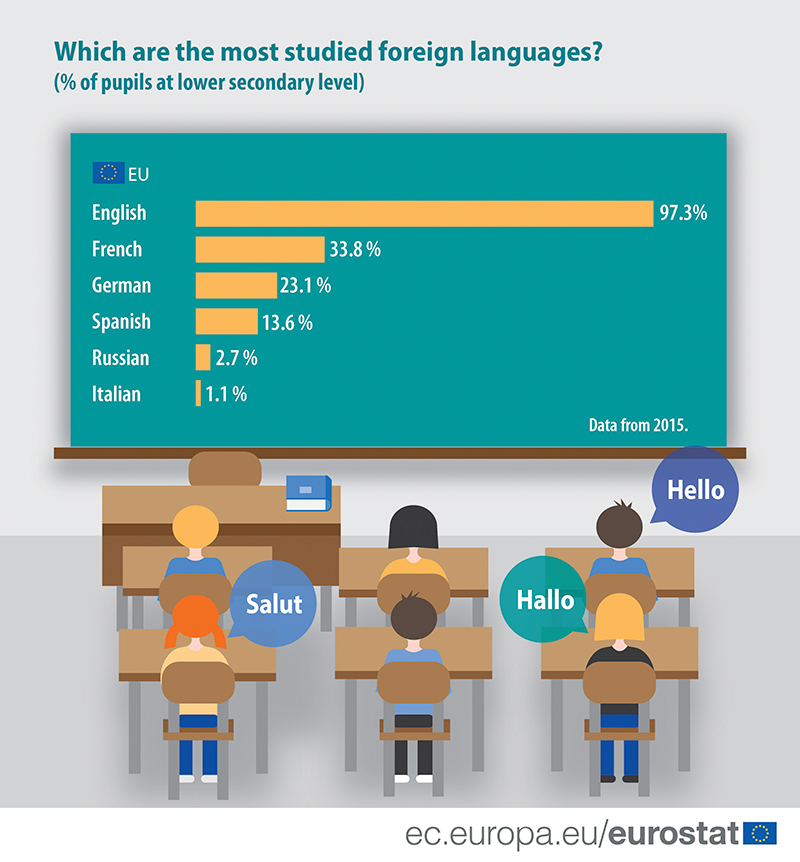Currently there are 24 official languages recognised within the European Union (EU), in addition to which there are regional, minority languages, and languages spoken by migrant populations.
In 1958, legislation specified German, French, Italian and Dutch as the official and working languages of the European Union’s (EU) predecessor, the European Communities. There have always been fewer official languages than EU Member States, as some share common languages, for example in Belgium where the official languages are Dutch, French and German, while in Cyprus the majority of the population speaks Greek. Since Croatia’s accession there are 24 official languages recognised within the EU. In addition there are indigenous regional, minority languages (such as Catalan, Galician and Basque in Spain, or Welsh and Scottish Gaelic in the United Kingdom), and languages that have been brought into the EU by migrant populations, notably Arabic, Turkish, Urdu, Hindi and Chinese. Some regional languages, such as Catalan and Welsh, have gained a status as co-official languages of the EU.
School and other educational institutions provide the main opportunity for the vast majority of people to learn languages, while linguistic diversity is actively encouraged within many further education establishments and workplaces. This article presents statistics on language learning in primary and secondary schools of the EU Member States, EFTA and candidate countries.
Primary education
Within primary education, a clear majority of pupils choose to learn English in the vast majority of EU Member States. All or nearly all (99–100 %) primary school pupils in Malta, Cyprus, Austria, Spain and Italy learnt English in 2014, as was also the case in Liechtenstein, Norway and the Former Yugoslav Republic of Macedonia. More than nine out of every ten primary school children learnt English in Poland, France and Croatia.
Many of the eastern and northern European Member States that joined the EU in 2004 or 2007 were characterised by the fact that learning Russian was compulsory in the past. This situation has changed rapidly and in most of these countries there has been a marked increase in the proportion of pupils learning English — by 2014 it often exceeded 50 % of all pupils. In Romania, Estonia, Latvia, the Czech Republic, Lithuania, Bulgaria and Slovakia this share was between 69 % and 82 % in 2014, rising to more than 90 % in Poland.
Luxembourg is also of particular interest, insofar as there are three official languages, with most pupils receiving instruction in Luxembourgish, German and French in primary education; English is only introduced at secondary school. A similar situation is observed in Belgium, with the focus in primary schools on learning French or Dutch (depending on the community and/or region), rather than English.
Apart from Luxembourg, the only other EU Member State where more than one quarter of primary school children learnt French as a foreign language was in the United Kingdom, where this share exceeded two thirds (70.2 %) in 2012. German is the main foreign language taught to all primary school children in Luxembourg, while around one fifth of primary school children were taught German in 2014 in Hungary and Croatia.
Secondary education
Turning to language learning in secondary general some 94.1 % of all EU-28 students at this level were studying English as a foreign language in 2014, compared with less than one quarter (23.0 %) studying French, while less than one fifth were studying Spanish (19.1 %) or German (18.9 %).
Between 2009 and 2014, the proportion of students in the EU-28 studying English was stable (down 0.1 percentage points), while the proportions studying French and German fell 3.0 and 4.2 percentage points respectively.
Just over half (51.2 %) of upper secondary general education in the EU-28 studied two or more languages in 2014, down from 51.4 % in 2009. Luxembourg stood out as the EU Member State with the highest proportion (100 %) of upper secondary general education students learning two or more languages, although shares of 98.6 % or higher were recorded in Finland, Romania, Slovakia and France. By far the lowest shares of secondary education students learning two or more languages, all below 10 %, were recorded in Portugal, Ireland, the United Kingdom and Greece.
Between 2009 and 2014, France observed a large increase in the proportion of upper secondary general education students learning two or more languages, up from 90.6 % to 98.6 %. Only five other EU Member States reported an increase between 2009 and 2014. The largest decreases during the same period were reported for Denmark, Malta (2010–14) and Sweden, down by more than 10 percentage points. Norway reported an even larger fall, down to 35.1 % in 2014 from 100.0 % in 2009.
